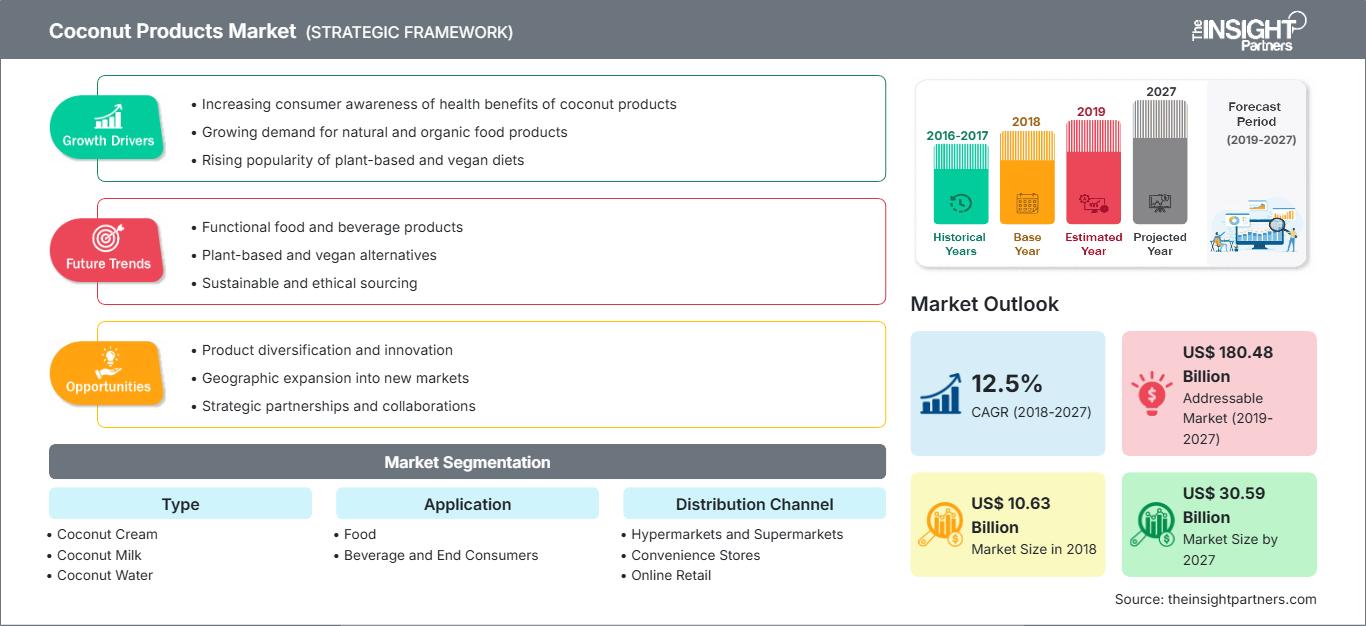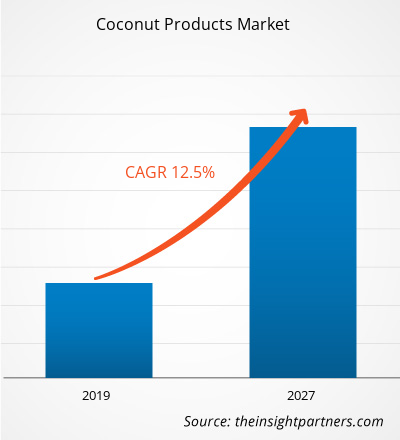[研究报告]2018年椰子制品市场价值为106.2783亿美元,预计到2027年将达到305.8753亿美元;预计2019年至2027年的复合年增长率为12.5%。
椰子营养丰富,富含膳食纤维;维生素C、E、B1、B3、B5和B6;以及钠、铁、钙、镁、磷和硒等矿物质。椰子制品,即从椰子中提取或衍生的产品,可以改善心血管健康,促进血糖控制,有助于减肥,并增强阿尔茨海默病患者的脑功能。椰子水有益于肾脏健康,具有保护心脏的作用,在运动后具有补水功效,有助于维持血压水平,并有助于糖尿病管理。
预计北美椰子制品市场在预测期内将以最高的复合年增长率增长。该地区市场的增长主要归因于消费者对健康食品和配料(例如椰子制品)的偏好。美国、加拿大和墨西哥等国家的消费者对饮食和食物摄入的关注度有所提高。此外,对椰奶、椰奶奶油和酒精饮料中的椰水等椰子制品的需求激增,进一步刺激了北美对椰子制品的需求。美国是该地区的主要市场,其次是加拿大和墨西哥。北美将成为椰子制品投资的诱人市场,因为这些产品在食品饮料和餐饮服务行业中被广泛使用。
自定义此报告以满足您的要求
您将免费获得任何报告的定制,包括本报告的部分内容,或国家级分析、Excel 数据包,以及为初创企业和大学提供超值优惠和折扣
椰子产品市场: 战略洞察

- 获取本报告的主要市场趋势。这个免费样本将包括数据分析,从市场趋势到估计和预测。
您将免费获得任何报告的定制,包括本报告的部分内容,或国家级分析、Excel 数据包,以及为初创企业和大学提供超值优惠和折扣
椰子产品市场: 战略洞察

- 获取本报告的主要市场趋势。这个免费样本将包括数据分析,从市场趋势到估计和预测。
由于封锁、旅行禁令和企业倒闭,
COVID-19 疫情对各国的经济和行业产生了不利影响。由于全球大流行危机和各国无限期封锁,食品和饮料行业对家庭必需品、健康食品和保质期较长的食品的需求旺盛。因此,对椰粉、椰油、椰奶、椰奶等国产和保质期长的椰子产品的需求也在增加。目前,市场上的主要椰子生产商面临着供应链挑战和产品消费量低的问题。主要参与者正致力于修改和调整其供应链,以加强其在线业务和交付措施,试图适应当前的
商业形势。消费者购买行为、饮食习惯的变化以及向在线分销渠道的重大转变可能会对预测期内椰子制品市场的增长产生严重影响。
市场洞察:食品配方和其他食品中椰子衍生物的使用增加预计将推动椰子制品市场的增长
椰子和椰子衍生物已成为多种食品配方和产品的主要成分。椰子油、牛奶、面粉、水、奶油和糖;椰蓉或椰丝;椰蓉等产品广泛用于各种食品和饮料中。在亚洲国家,初榨椰子油被广泛用作食用油。椰子油是一种独特的食用油,因为它含有短链和中链饱和脂肪酸。由于其易熔性、宜人的风味、良好的消化性和抗氧化酸败性,它在食品工业中得到广泛应用。它也可以用于人造黄油的生产。椰子油是婴儿奶粉、代乳品、冰淇淋和糖果以及烘焙产品的首选脂肪来源。脱水椰子主要用于糖果和其他食品行业。脱水椰子也可作为椰蓉的替代品,用于各种家用食品的制作。椰奶是一种速溶产品,可直接使用或加水稀释,用于制作咖喱、糖果、甜点、鱼类和肉类菜肴、饼干、鸡尾酒、布丁、蛋糕、冰淇淋、椰酱等。方便食品生产对椰子产品的需求也在增长。椰子饼干在即食零食产品类别中越来越受欢迎,其主要成分是通用面粉和椰子粉,以及黄油、可可和生姜等其他用于提升口感的配料。椰子饼干在常温下保质期为三个月。这些饼干美味可口,营养丰富,低热量,高纤维,在美国以及亚太、欧洲、中东和非洲国家广受欢迎。此外,椰子糖是另一种以椰子为原料的产品,由椰奶和椰丝混合而成。这是一种主要产于亚太国家的新型零食。椰子巧克力由椰蓉和椰奶糖混合而成,表面裹有巧克力。该产品在冷藏条件下保质期为三个月。它在欧洲、澳大利亚、北美、中东和中国有着广泛的需求。
类型洞察
根据类型,椰子产品市场可分为椰奶、椰奶、椰子水、椰子糖、椰子油、椰丝、椰蓉等。2019 年,椰子油占据了更大的市场份额。椰子油是一种无色无味的产品,提取自成熟椰子的果仁。根据提取方式,椰子油分为未精制和精制或初榨两种。根据美国国家生物技术信息中心 (NCBI) 发布的一份报告,椰子油对阿尔茨海默病患者有积极作用,因为它可以减少与该病相关的认知缺陷。此外,剑桥大学的一项研究表明,椰子油可以降低患心血管疾病的风险。椰子油可以提高高密度脂蛋白 (HDL),即“好胆固醇”的水平,从而降低患心脏病的风险。此外,椰子油中的脂肪酸有助于燃烧体内有害脂肪,从而为大脑和身体机能提供能量。在印度和中国等亚洲国家,椰子油用于烹饪。印度政府开展了一系列宣传活动,强调椰子油的健康益处,以振兴国内椰子产业。此外,由于其抗衰老、抗氧化和抗菌特性,椰子油也被用于化妆品行业。
应用洞察
根据应用,椰子产品市场可细分为食品、饮料和终端消费者。食品领域在 2019 年占据了最大的市场份额。椰子产品用于咖喱、糖果、烘焙食品、零食等多种用途。对更健康乳制品替代品的需求不断增长,预计将增加椰子产品在食品中的应用。椰子水、椰子油和椰奶在亚洲和泰国烹饪中被广泛使用。椰子产品的甜味和坚果味适用于从烤红薯到糖果棒等各种食品。消费者日益增强的健康意识也增加了对含有椰子产品的食品的需求。椰子产品富含矿物质、维生素、锰、钙、磷和许多其他营养素。椰奶含有高热量,其中 93% 的热量来自中链甘油三酯 (MCT)。中链甘油三酸酯 (MCT) 有助于减肥、促进新陈代谢并增强身体机能。此外,椰子中含有大量的锰,对骨骼健康和促进新陈代谢至关重要。食用初榨椰子油有助于减少腹部脂肪,而腹部脂肪是导致糖尿病和心脏病的主要原因之一。椰奶和酸奶正在取代牛奶在许多食品和美食中的传统用途。此外,乳糖不耐症在人群中的患病率急剧上升,也增加了椰奶的使用量。
椰子产品市场的一些参与者包括 Marico、百事可乐公司、可口可乐公司、椰子公司、Nexpo Conversion、达能公司、雀巢公司、Sambu 集团、泰国农业食品有限公司和泰国椰子公共有限公司等。重点公司实施并购和研发战略,以扩大客户群并在全球市场上获得显著份额,这也使他们能够在全球范围内维护自己的品牌名称。
椰子产品市场椰子产品市场
The Insight Partners 的分析师已详尽阐述了预测期内影响椰子产品市场的区域趋势和因素。本节还讨论了北美、欧洲、亚太地区、中东和非洲以及南美和中美洲的椰子产品市场细分和地域分布。
椰子产品市场报告范围
| 报告属性 | 细节 |
|---|---|
| 市场规模 2018 | US$ 10.63 Billion |
| 市场规模 2027 | US$ 30.59 Billion |
| 全球复合年增长率 (2018 - 2027) | 12.5% |
| 历史数据 | 2016-2017 |
| 预测期 | 2019-2027 |
| 涵盖的领域 |
By 类型
|
| 覆盖地区和国家 | 北美
|
| 市场领导者和主要公司简介 |
|
椰子产品市场参与者密度:了解其对商业动态的影响
椰子产品市场正在快速增长,这得益于终端用户需求的不断增长,而这些需求的驱动因素包括消费者偏好的不断变化、技术进步以及对产品益处的认知度不断提高。随着需求的增长,企业正在扩大产品线,不断创新以满足消费者需求,并抓住新兴趋势,从而进一步推动市场增长。

- 获取 椰子产品市场 主要参与者概述
- 椰子制品市场不断发展的行业趋势,帮助参与者制定有效的长期战略
- 发达市场和发展中市场采用的业务增长战略
- 2019 年至 2027 年椰子制品市场的定量分析
- 全球椰子制品需求估算
- PEST 分析,说明行业买家和供应商的效率
- 了解竞争激烈的市场形势
- 市场趋势和前景,以及推动和抑制椰子制品市场增长的因素
- 通过强调支撑商业利益的市场策略来协助决策过程,从而促进市场增长
- 不同节点的椰子制品市场规模
- 市场的详细概述和细分,以及椰子制品行业动态
- 具有良好增长机会的各地区椰子制品市场规模
椰子制品市场 - 按类型
- 椰子奶油
- 椰奶
- 椰子水
- 椰子糖
- 椰子油
- 椰子碎/椰丝
- 椰子干
- 其他
椰子产品市场 -按应用
- 食品
- 饮料
- 最终消费者
椰子产品市场 - 按分销渠道
- 大卖场和超市
- 便利店
- 网上零售
- 其他
公司简介
- Marico
- 百事可乐公司
- 可口可乐公司
- 椰子公司
- Nexpo Conversion
- 达能公司
- 雀巢公司
- Sambu 集团
- 泰国农业食品有限公司
- 泰国椰子公众有限公司
- 历史分析(2 年)、基准年、预测(7 年)及复合年增长率
- PEST和SWOT分析
- 市场规模、价值/数量 - 全球、区域、国家
- 行业和竞争格局
- Excel 数据集
近期报告
相关报告
客户评价
购买理由
- 明智的决策
- 了解市场动态
- 竞争分析
- 客户洞察
- 市场预测
- 风险规避
- 战略规划
- 投资论证
- 识别新兴市场
- 优化营销策略
- 提升运营效率
- 顺应监管趋势




















 获取免费样品 - 椰子产品市场
获取免费样品 - 椰子产品市场